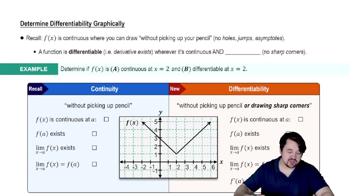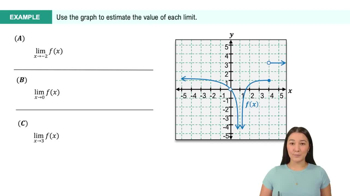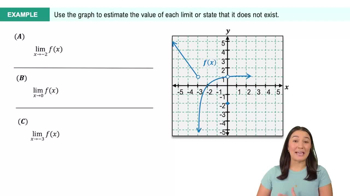Table of contents
- 0. Functions7h 52m
- Introduction to Functions16m
- Piecewise Functions10m
- Properties of Functions9m
- Common Functions1h 8m
- Transformations5m
- Combining Functions27m
- Exponent rules32m
- Exponential Functions28m
- Logarithmic Functions24m
- Properties of Logarithms34m
- Exponential & Logarithmic Equations35m
- Introduction to Trigonometric Functions38m
- Graphs of Trigonometric Functions44m
- Trigonometric Identities47m
- Inverse Trigonometric Functions48m
- 1. Limits and Continuity2h 2m
- 2. Intro to Derivatives1h 33m
- 3. Techniques of Differentiation3h 18m
- 4. Applications of Derivatives2h 38m
- 5. Graphical Applications of Derivatives6h 2m
- 6. Derivatives of Inverse, Exponential, & Logarithmic Functions2h 37m
- 7. Antiderivatives & Indefinite Integrals1h 26m
- 8. Definite Integrals4h 44m
- 9. Graphical Applications of Integrals2h 27m
- 10. Physics Applications of Integrals 2h 22m
1. Limits and Continuity
Introduction to Limits
Problem 33d
Textbook Question
Determine whether the following statements are true and give an explanation or counterexample.
d. . (Hint: Graph y=√x)
 Verified step by step guidance
Verified step by step guidance1
Consider the function \( y = \sqrt{x} \) and its behavior as \( x \to 0 \).
Note that the square root function \( \sqrt{x} \) is only defined for \( x \geq 0 \).
As \( x \to 0^+ \) (approaching 0 from the right), \( \sqrt{x} \to \sqrt{0} = 0 \).
Since \( \sqrt{x} \) is not defined for \( x < 0 \), the limit from the left does not exist.
Therefore, the limit \( \lim_{x \to 0} \sqrt{x} \) does not exist because it is only defined from the right.
 Verified video answer for a similar problem:
Verified video answer for a similar problem:This video solution was recommended by our tutors as helpful for the problem above
Video duration:
1mPlay a video:
Was this helpful?
Key Concepts
Here are the essential concepts you must grasp in order to answer the question correctly.
Limits
A limit is a fundamental concept in calculus that describes the behavior of a function as its input approaches a certain value. It helps in understanding how functions behave near points of interest, including points where they may not be defined. For example, the limit of √x as x approaches 0 examines the value that √x approaches as x gets closer to 0.
Recommended video:

One-Sided Limits
Square Root Function
The square root function, denoted as √x, is defined for non-negative values of x and returns the non-negative value whose square is x. This function is continuous and increases as x increases. Understanding its graph is crucial for analyzing limits, especially as it approaches 0, where the function's behavior can be visually interpreted.
Recommended video:

Multiplying & Dividing Functions
Graphical Interpretation
Graphical interpretation involves analyzing the visual representation of a function to understand its behavior. For the function y = √x, the graph is a curve that starts at the origin (0,0) and rises to the right. By examining this graph, one can intuitively grasp how the function behaves as x approaches 0, which aids in determining the limit.
Recommended video:

Determining Differentiability Graphically

 6:47m
6:47mWatch next
Master Finding Limits Numerically and Graphically with a bite sized video explanation from Callie
Start learning




